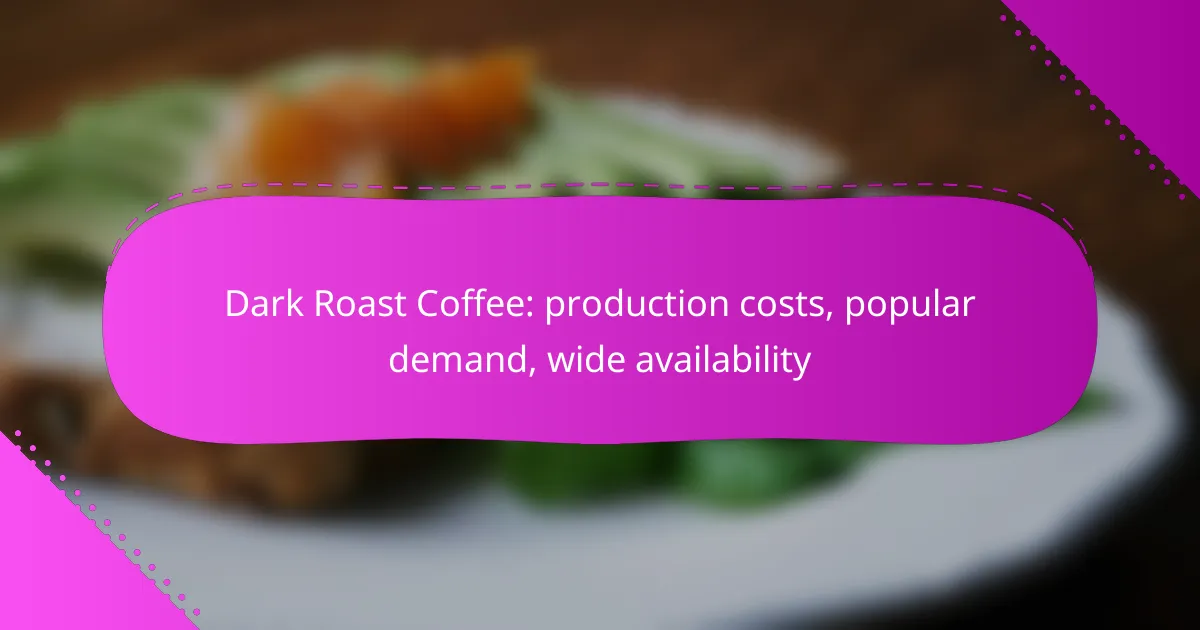Dark roast coffee has become increasingly popular in New Zealand, driven by a consumer preference for bold flavors and the rise of specialty coffee. The production costs are influenced by the quality of beans and roasting methods, affecting pricing for both producers and consumers. Fortunately, dark roast options are widely available, making it easy for coffee lovers to find their favorite blends in supermarkets and cafes across the country.
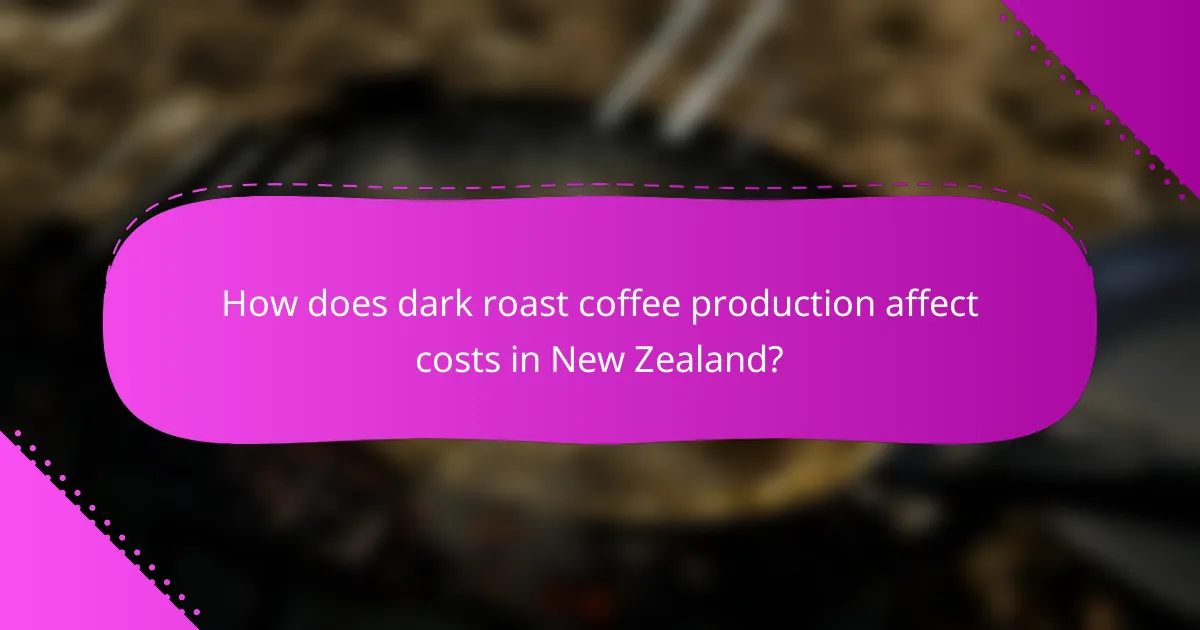
How does dark roast coffee production affect costs in New Zealand?
The production of dark roast coffee in New Zealand significantly influences its costs due to factors such as sourcing quality beans and the methods used in roasting. These elements contribute to the overall pricing structure, impacting both producers and consumers.
High production costs due to sourcing
Sourcing high-quality beans for dark roast coffee is often a major expense, as premium beans can come from specific regions known for their flavor profiles. In New Zealand, the cost of importing these beans can vary widely, typically ranging from low tens to high tens of NZD per kilogram, depending on the origin and quality.
Additionally, local regulations and sustainability practices can further elevate sourcing costs. Producers may choose to invest in ethically sourced beans, which can lead to higher prices but also appeal to environmentally conscious consumers.
Impact of roasting methods on pricing
The roasting method used for dark roast coffee also plays a crucial role in determining its price. Traditional roasting techniques, which require more time and energy, can increase production costs. For instance, small-batch roasting may yield a superior flavor but often comes at a premium price.
Conversely, larger commercial roasters may utilize more efficient methods, potentially lowering costs. However, this can sometimes compromise the flavor quality that consumers expect from dark roast coffee. Ultimately, the choice of roasting method affects both the cost to the consumer and the perceived value of the product.
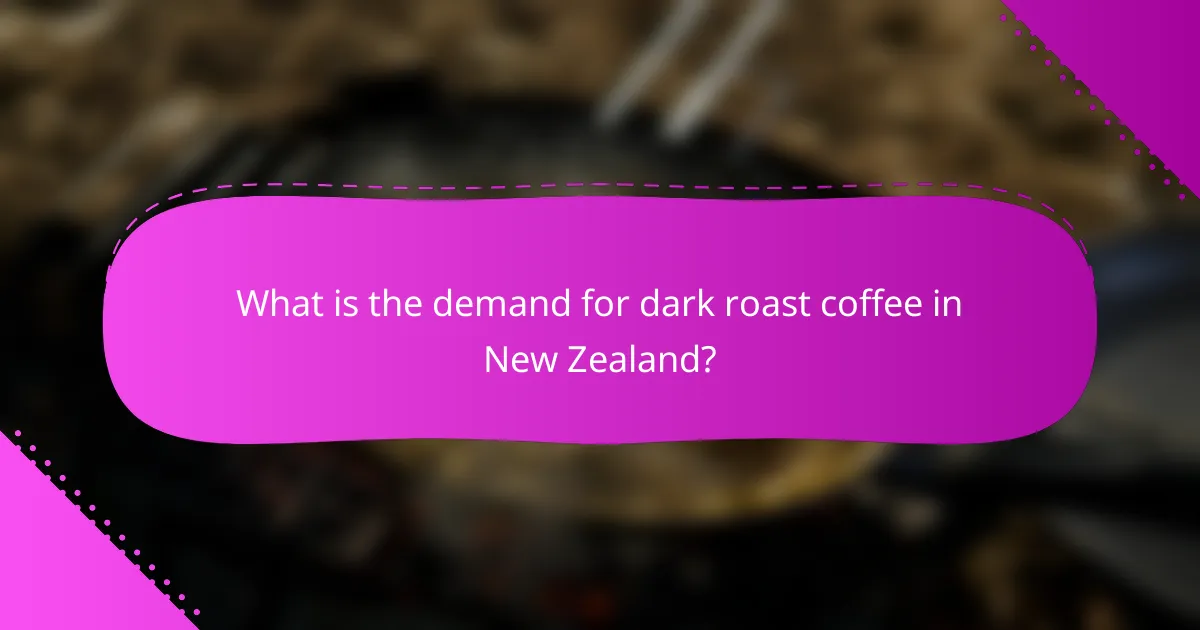
What is the demand for dark roast coffee in New Zealand?
The demand for dark roast coffee in New Zealand has been steadily increasing, reflecting a growing preference for bold flavors among consumers. This trend is driven by both the popularity of specialty coffee and the availability of diverse dark roast options in cafes and supermarkets.
Growing popularity among consumers
Dark roast coffee has gained traction among New Zealand consumers who appreciate its rich, robust taste. Many coffee drinkers are shifting from lighter roasts to darker varieties, seeking a more intense flavor profile that dark roasts provide. This shift is evident in the rising sales figures for dark roast products across various retail channels.
Additionally, the influence of social media and coffee culture has played a significant role in promoting dark roast coffee. Consumers often share their experiences and preferences online, further fueling interest in these bold brews.
Trends in specialty coffee shops
Specialty coffee shops in New Zealand are increasingly featuring dark roast options on their menus, catering to the growing demand for these flavors. Many cafes are experimenting with different brewing methods to highlight the unique characteristics of dark roasts, such as espresso and French press. This experimentation not only attracts coffee enthusiasts but also educates consumers about the nuances of dark roast coffee.
Furthermore, some specialty shops are sourcing their beans from specific regions known for high-quality dark roasts, enhancing the overall experience for customers. This focus on quality and origin aligns with the broader trend of consumers seeking transparency and sustainability in their coffee choices.
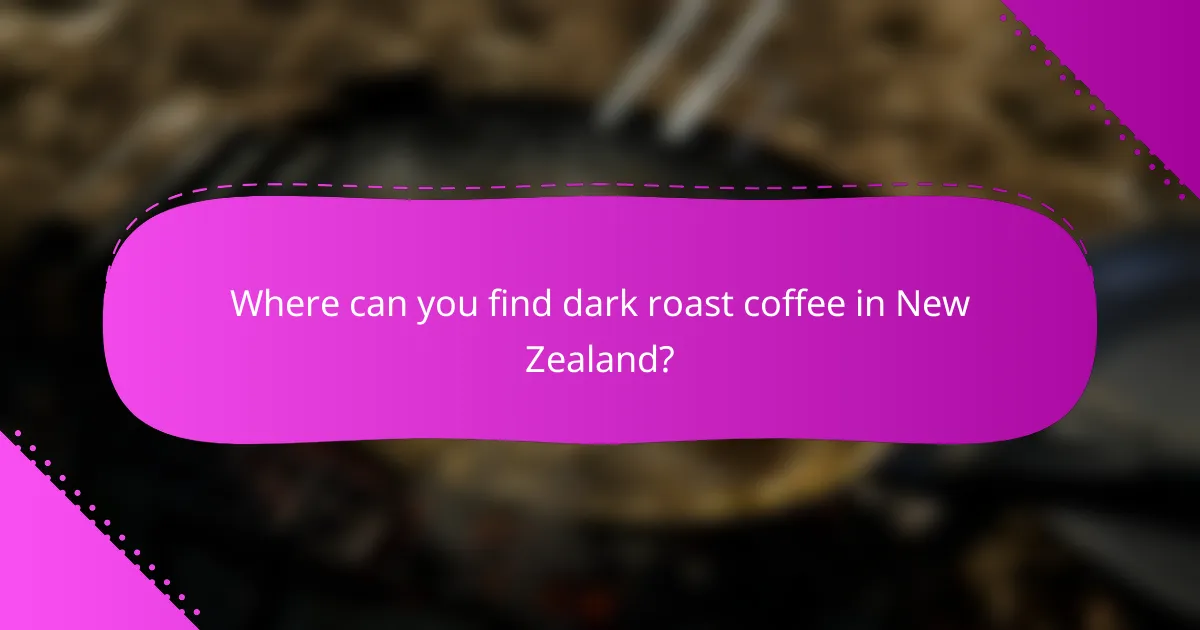
Where can you find dark roast coffee in New Zealand?
Dark roast coffee is widely available across New Zealand, from major supermarkets to specialty coffee shops. Consumers can easily access a variety of brands and blends that cater to different tastes and preferences.
Availability in major supermarkets
Most major supermarkets in New Zealand, such as Countdown and New World, stock a range of dark roast coffee options. These typically include both ground coffee and whole beans from popular brands like Robert Harris and Moccona.
Prices for dark roast coffee in supermarkets generally range from NZD 10 to NZD 20 for a 250g to 500g package, depending on the brand and quality. Look for sales or promotions to get the best deals.
Online retailers offering dark roast options
Online shopping for dark roast coffee is convenient in New Zealand, with retailers like Trade Me and Coffee Direct offering extensive selections. These platforms often feature local roasters, providing unique blends that may not be available in stores.
When purchasing online, consider shipping costs and delivery times, which can vary. Many retailers offer free shipping for orders over a certain amount, typically around NZD 50, making it cost-effective to stock up on your favorite blends.
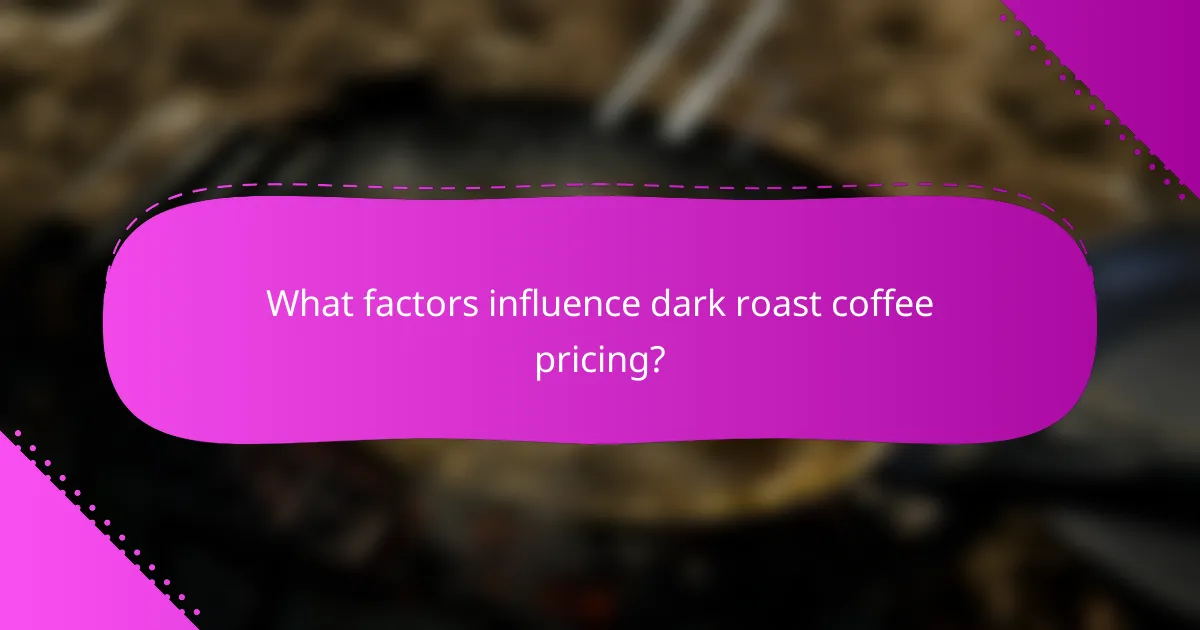
What factors influence dark roast coffee pricing?
Dark roast coffee pricing is influenced by several key factors, including market competition, the quality of beans, and the roasting techniques used. Understanding these elements can help consumers make informed choices when purchasing dark roast coffee.
Market competition among brands
Market competition plays a significant role in determining the price of dark roast coffee. With numerous brands vying for consumer attention, prices can vary widely based on brand reputation, marketing strategies, and distribution channels. Popular brands may command higher prices due to established loyalty, while newer or lesser-known brands might offer lower prices to attract customers.
Additionally, seasonal trends and consumer preferences can shift demand, impacting pricing. For instance, during peak coffee seasons or holidays, prices may rise due to increased demand, while off-peak times might see discounts as brands compete for sales.
Quality of beans and roasting techniques
The quality of beans used in dark roast coffee significantly affects its price. High-quality, specialty-grade beans sourced from reputable regions often come at a premium. Factors such as altitude, climate, and processing methods contribute to the overall quality and, subsequently, the cost of the coffee.
Roasting techniques also influence pricing. Artisanal roasting methods that require more time and skill can lead to higher prices compared to mass-produced options. Consumers should consider both the origin of the beans and the roasting process when evaluating the value of dark roast coffee, as these elements directly impact flavor and quality.
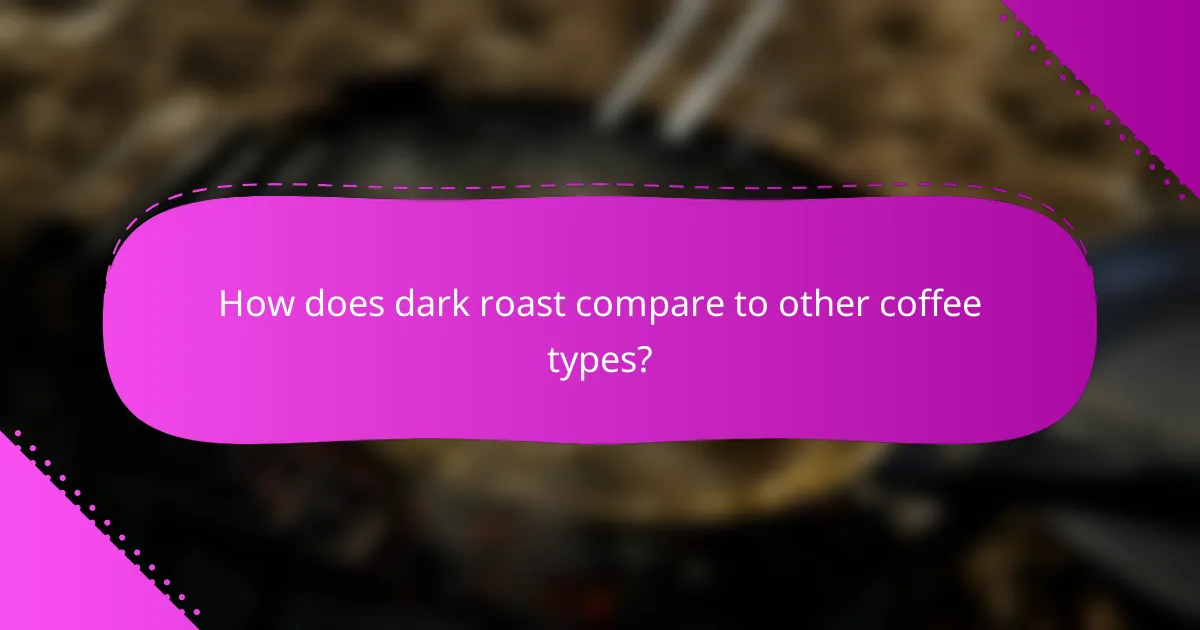
How does dark roast compare to other coffee types?
Dark roast coffee differs from other types primarily in flavor, caffeine content, and production costs. While it is known for its bold, rich taste, it generally has a lower caffeine level compared to lighter roasts, and its production can be more cost-effective due to the roasting process.
Flavor profile differences
Dark roast coffee is characterized by its deep, smoky flavors and a pronounced bitterness, often overshadowing the original bean’s unique characteristics. In contrast, lighter roasts tend to highlight the bean’s origin, offering fruity or floral notes. This difference in flavor profiles can influence consumer preferences significantly.
For those who enjoy a robust coffee experience, dark roasts are often favored. However, coffee enthusiasts seeking complexity may prefer lighter roasts for their nuanced flavors.
Caffeine content comparison
While many believe that dark roast coffee contains more caffeine, this is a common misconception. In reality, lighter roasts typically have higher caffeine levels by volume due to the shorter roasting time, which preserves more caffeine. Dark roasts, being roasted longer, lose some caffeine content, though the difference is often minimal.
For practical purposes, a standard 8-ounce cup of dark roast coffee may contain around 80-100 mg of caffeine, while a similar serving of light roast could have about 90-110 mg. Consumers should consider their caffeine sensitivity when choosing between roast types.

What are the health benefits of dark roast coffee?
Dark roast coffee offers several health benefits, including high antioxidant levels and potential digestive advantages. These benefits can contribute to overall well-being when consumed in moderation.
Antioxidant levels in dark roast
Dark roast coffee is rich in antioxidants, which help combat oxidative stress in the body. The roasting process enhances the concentration of certain antioxidants, such as chlorogenic acids, which may support heart health and reduce inflammation.
When choosing dark roast coffee, look for brands that emphasize high-quality beans, as these often have better antioxidant profiles. Regular consumption can provide a boost to your daily antioxidant intake, complementing a balanced diet.
Potential digestive benefits
Dark roast coffee may offer digestive benefits, particularly for those with sensitive stomachs. The longer roasting time can reduce the acidity of the coffee, making it gentler on the digestive system compared to lighter roasts.
For individuals who experience discomfort with regular coffee, switching to a dark roast can be a practical solution. Additionally, some studies suggest that coffee can stimulate digestion, potentially aiding in the breakdown of food.
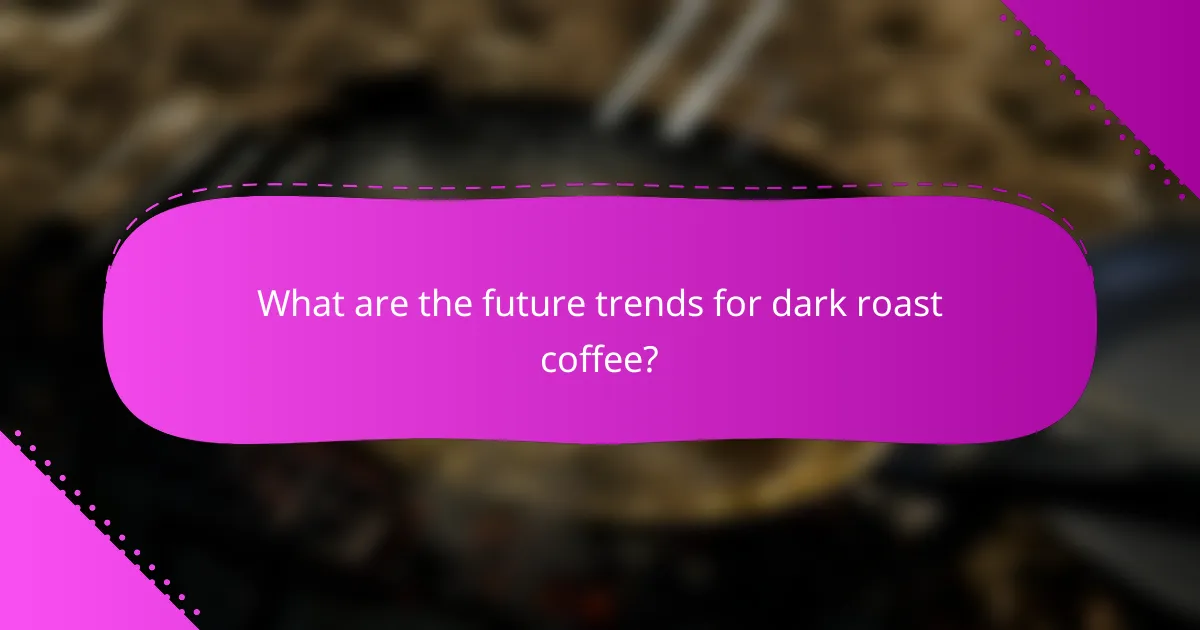
What are the future trends for dark roast coffee?
Future trends for dark roast coffee indicate a growing popularity driven by consumer preferences for bold flavors and rich aromas. As coffee enthusiasts seek unique experiences, the demand for high-quality dark roasts is expected to rise, influencing production practices and market availability.
Production costs of dark roast coffee
The production costs of dark roast coffee can vary significantly based on factors such as bean quality, sourcing practices, and roasting methods. Generally, high-quality Arabica beans, often used for dark roasts, may cost between $2 to $5 per pound, depending on origin and market conditions.
Roasting processes also impact costs; smaller roasters may face higher per-unit expenses due to limited scale. Additionally, energy costs for roasting can fluctuate, affecting overall production expenses. Understanding these factors helps producers manage pricing strategies effectively.
Popular demand for dark roast coffee
Dark roast coffee has seen a surge in popularity, particularly among consumers who enjoy robust flavors and lower acidity. This trend is evident in specialty coffee shops and retail markets, where dark roasts often account for a significant portion of sales.
Consumer preferences are shifting towards artisanal and sustainably sourced dark roasts, with many willing to pay a premium for quality. This demand encourages producers to focus on unique flavor profiles and ethical sourcing practices, enhancing the overall market appeal.
Wide availability of dark roast coffee
The wide availability of dark roast coffee is driven by its popularity and the increasing number of specialty coffee roasters. Consumers can find dark roasts in various formats, including whole beans, ground coffee, and ready-to-drink options, across supermarkets and online platforms.
As the market expands, many brands are offering dark roast blends that cater to diverse tastes, making it easier for consumers to access their preferred flavor profiles. This accessibility supports the continued growth of dark roast coffee in both local and international markets.
